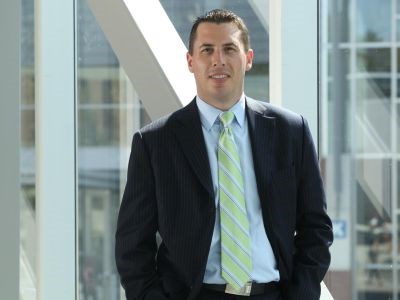Craig Fowler sees the Sudbury community as an ecosystem, one in which Laurentian University can flourish symbiotically with industry and government.
“Communities are really ecosystems and the ultimate goal of an ecosystem is productivity and sustainability,” said Fowler. “Universities as the knowledge creator, or part of that chain in the ecosystem, are very important. You're either a big industry partner, or with a university.”
Fowler hopes to bring industry and academia closer together and access government initiatives in his newly announced role of associate vice-president of research and innovation at Laurentian.
“He's about finding research opportunities and leveraging private interests and academic research and putting that together and making that happen,” said Sherry Drysdale, Laurentian's head of communications and marketing.
Laurentian's Strategic Plan (2012-2017) involves expanding on the existing research and innovation file, and national and international projects and partnerships are taking root.
The growth requires support, and the university is creating new positions to advance the plan. They created Fowler's role earlier this year, and while he officially took the new title on in March, he was well primed for the opportunity.
Fowler has been with Laurentian since 2012, as the associate vice-president of administration and external relations. In his role at Laurentian he'd worked on the Barrie campus on marketing, community engagement and government relations.
In his research position, Fowler will get to focus even more on the government relations aspect, and engage more with industry. He describes himself as the “go-to university leader for industry as well as governments and economic development agencies for research and development.”
“Academia is optimally designed to engage industry,” said
Fowler. “Industry might not have research and development budgets, but they can
access government funding through the university, and also access our great
researchers, faculty and students.”
Fowler said he will be working on several projects that have already begun.
Metal Earth is a $65-million program that is seeking funding from the Canada First Research Excellence Fund and brings together Laurentian and international researchers and industry partners to study the Precambrian era and metal endowment over space and time. The data could be used by industry for more sustainable development of Northern mineral deposits and more efficient surveying and exploration.
Another project, Integrated Multi-Parameter Footprints of Ore Systems, or Footprints, was launched in 2013. It brings together 42 researchers at 24 universities across Canada and 27 mining, mineral exploration, mineral exploration services, and software companies across Canada for the geoscience research project.
It has five years of funding worth over $13 million from the Canadian government the support of the Canadian Mining Innovation Council.
International developments include several memorandums of understanding (MOUs) signed in China, including one with the China University for Mining and Technology to work together on ultra-deep mining research.
Fowler said projects like these exemplify the way academia, industry and government are working together to optimize opportunities.
Long before joining Laurentian, Fowler graduated from the University of Waterloo with a degree in urban planning, and then worked as an economic development officer, and in a variety of roles, many focussed on research and development with the Ontario government.
Fowler said his passion for research, innovation and economic development was born of the limitations in his urban planning roles.
“One of my internal struggles as a planner was that we would say, ‘What can go on a parcel of land,” said Fowler. “No one was asking what I thought was a very crucial question: what should go on a parcel of land, instead of what can.”
“I felt like if you get the ‘should’ right you could create more sustainability in an ecosystem.”



